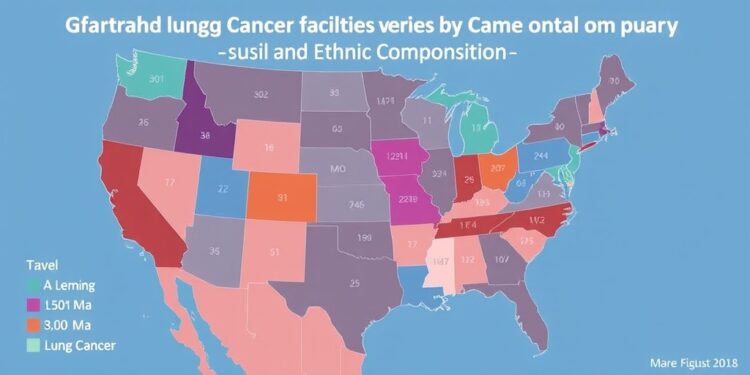The disparity in healthcare access, particularly regarding lung cancer screening, highlights an alarming trend in the United States. A new study published in the esteemed Annals of Internal Medicine elucidates the stark differences in travel distances to lung cancer screening facilities across various racial and ethnic communities. This research, conducted by a coalition of experts from Washington State University and Swedish Cancer Institute, reveals that the American Indian/Alaska Native (AI/AN) populations encounter significant challenges compared to their non-Hispanic White counterparts. The implications of these findings are monumental and call for urgent action to address the existing inequities in healthcare access.
The researchers embarked on a comprehensive analysis involving data from over 71,000 census tracts across the U.S., aiming to determine how race, ethnicity, and rurality influence the distance individuals must travel to reach lung cancer screening centers. Their observations underscore a troubling reality: AI/AN populations, which exhibit high smoking prevalence rates, find themselves situated an astonishing five times farther from screening facilities when compared to non-Hispanic White populations. This extensive geographic gap is particularly concerning, given lung cancer is the leading cause of cancer deaths among AI/AN communities.
Many factors contribute to the disparities identified in this study. The research highlights that while rurality, or the urban versus rural status of a census tract, plays a role in determining access to healthcare facilities, it does not fully explain the discrepancies observed. For instance, despite AI/AN-majority census tracts being predominantly rural, the distance residents must cover to reach nearby lung cancer screening centers is profoundly greater: an average of nearly 50 miles. In stark contrast, non-Hispanic White-majority tracts report distances ranging between just 4.4 to 6.9 miles to LCS facilities.
Even when the distances were adjusted for the rurality factor, the findings did not reflect a level playing field. The mean distance for AI/AN-majority tracts remained significantly higher than that of non-Hispanic White tracts—more than three times the difference. The researchers noted that the distance barriers diminish somewhat for other racial and ethnic groups, including Asian and Black populations. However, these groups still face considerable travel challenges. Asian-majority tracts showcased an approximately 16% reduction in distance compared to their non-Hispanic White counterparts, while Black-majority tracts exhibited a 39% shorter travel distance.
What’s most disheartening is the finding that geographic isolation significantly hampers both awareness and access to life-saving health interventions, such as lung cancer screenings. The troubling implications of these facts are compounded by the increased mortality rates observable within these underserved communities. Addressing these gaps is essential for reducing the health disparities present in the U.S. healthcare system, particularly in regard to early detection of cancer.
The leading authors of this study emphasize that these findings highlight a crucial area for public health intervention. There is an evident need for healthcare policymakers and organizations to pay attention to the geographic distribution of healthcare resources, especially regarding preventative screenings. The consequences of inaction are dire, as lung cancer continues to claim lives at an alarming rate, particularly among populations that are already wrestling with systemic health care challenges.
The implications of these findings extend beyond travel distances. They serve as a catalyst for health systems to critically evaluate their current practices and consider implementing more equitable solutions. By fostering a more inclusive healthcare landscape, stakeholders can begin to dismantle the barriers that inhibit access for marginalized communities and work toward improving overall health outcomes.
Moving forward, research efforts must continue to explore innovative solutions that not only address geographical disparities in healthcare access but also consider cultural and socioeconomic factors. Tailored approaches that resonate with the specific demographics of a given community could yield positive results in increasing cancer screening and reducing associated morbidity and mortality.
In conclusion, this research not only sheds light on the essential equity issues in healthcare access but also serves as a clarion call for stakeholders across the United States. It is imperative to listen to the voices of affected communities and address the structural inequities that have persisted for far too long. Ensuring that all individuals, regardless of their racial or ethnic background, have access to life-saving medical interventions must be a priority for public health initiatives in the years to come.
Solutions such as improving healthcare infrastructure, enhancing community awareness, and promoting mobile health units could pave the way towards narrowing these significant, yet preventable, health gaps. The research presented in the Annals of Internal Medicine is a starting point for a broader dialogue on healthcare equity—one that must gain traction to enact meaningful change and improve outcomes for all populations.
Subject of Research: Disparities in access to lung cancer screening facilities among different racial and ethnic communities in the U.S.
Article Title: Census Tract Rurality, Predominant Race and Ethnicity, and Distance to Lung Cancer Screening Facilities: An Ecological Study
News Publication Date: 14-Jan-2025
Web References:
References:
Image Credits:
Keywords: Lung cancer, Cancer screening, Public health, Healthcare equity, Health disparities.





